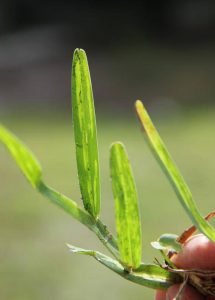Sugarcane mosaic virus (SCMV) is a virus of great concern for turfgrass aficionados. This past Winter, a local landscaper and I observed mottled, discolored turfgrass in an HOA located in Naples. We submitted samples of the turf to the molecular scientists at UF/IFAS turfgrass diagnostic services, and received a reports confirming that SCMV is culprit. So what do you need to know about SCMV?

Although the virus is named for its first known host, sugarcane, it affects turfgrasses in Florida. In the last decade, reports have sprung up all around the state of Florida. The virus is rarely reported in Collier County but has been present here for a number of years.
What is it?
SCMV only causes disease in some species and cultivars of turfgrass. For example, Zoysiagrass is not a host. All St. Augustine cultivars can become infected, but only a few cultivars experience complete die-back, including the popular cultivar St. Augustine “Floratam” which is very prevalent here in Collier County. The cultivars “CitraBlue” and “Palmetto” can become infected but won’t die back from the virus (although I tend not to recommend “Palmetto” as it is very vulnerable to chinch bugs in South Florida!).
Infected lawns are characterized by a blotchy, mosaic pattern of leaf damage. Look for mottled patches of yellow and light green on the grass blades. These symptoms can last for months (and can appear to temporarily lessen and return) before the grass begins to brown and die completely. It will take 1-3 years, but eventually “Floratam” lawns will experience complete die-back. When the virus kills the entire lawn, scientists say that the lawn is exhibiting what is called lethal viral necrosis (LVN). These lawns need to be replaced with a less susceptible turfgrass cultivar….
Read the full articles: https://blogs.ifas.ufl.edu/collierco/2022/06/21/sugarcane-mosaic-virus/
Source: UF/IFAS Alert – https://blogs.ifas.ufl.edu/



